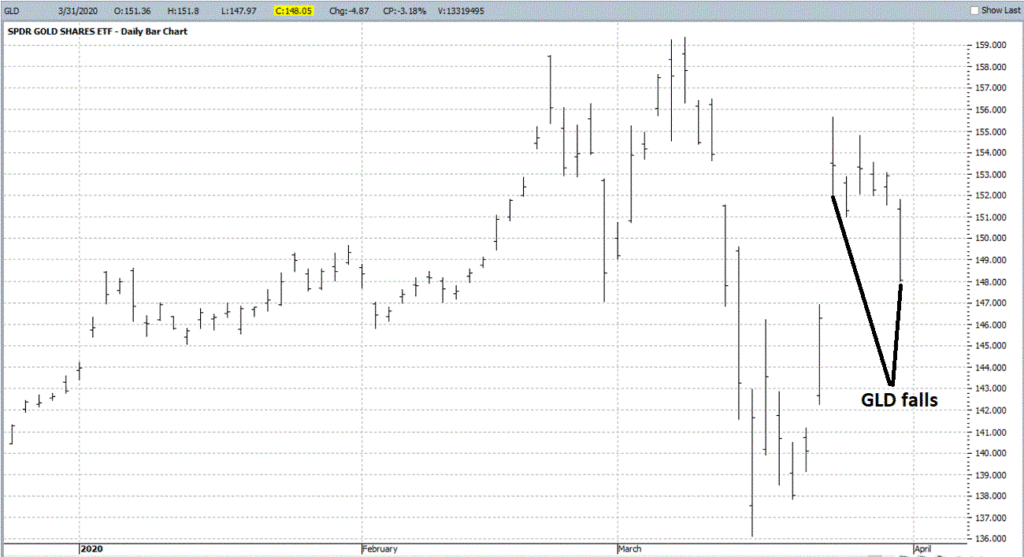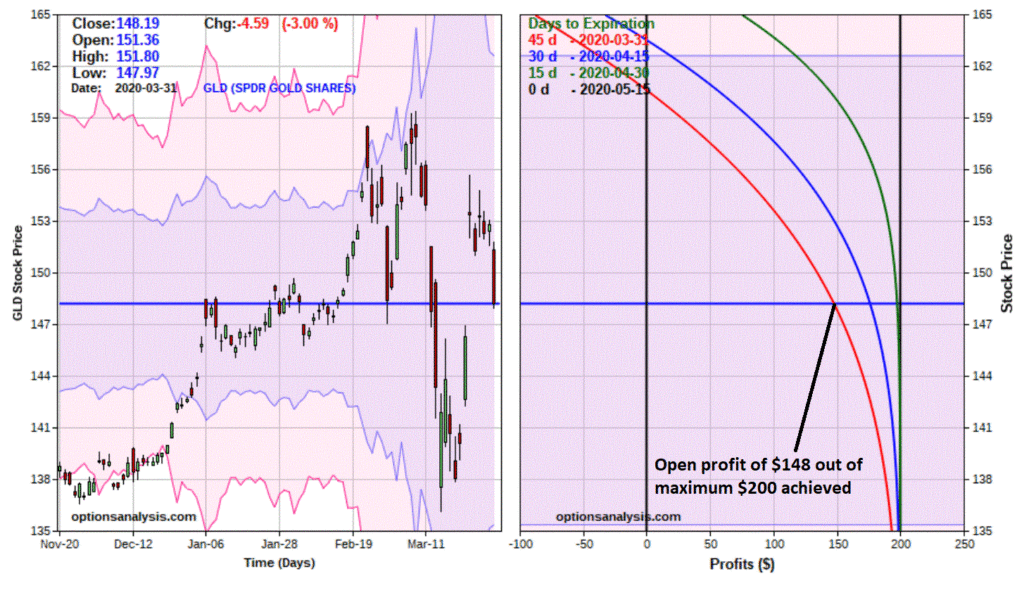In this article I detailed an example of a bear call spread using options on GLD. And while I got a little long-winded in detailing all of the considerations involved in selecting and entering this type of trade, for the sake of brevity the one thing I did not discuss was when to take a profit. Two important points on this:
*You absolutely, positively should have a profit-taking plan in place at the time you enter the trade.
*When trading options there are a variety of choices when it comes to taking profits.
When you get a profit on an option position you have several choices, including:
*Do nothing – i.e., let it ride
*Close the entire position – i.e., take your profit and move on
*Close part of the position and let the rest ride – i.e., take some money/risk off the table and still have the potential for further gains
*Adjust the existing position into another position – this is a more advanced topic, but is one of the great advantages available to option traders
Our GLD Bear Call Spread
In our example GLD trade we:
Sold 4 May2020 180 calls @ $2.60
Bought 4 May2020 185 calls @ $2.10
*Maximum profit potential is $200
*Maximum risk is -$1,800
Where Things Stand
Since the example trade was entered on 3/24, GLD has fallen from $153.40 a share to $148.05 as you can see in Figure 1.

Figure 1 – GLD falls (Courtesy ProfitSource by HUBB)
The out-of-the-money calls in our trade have both declined in value, and as of the close on 3/31 the trade had an open profit of $148. See Figures 2 and 3.

Figure 2 – GLD bear call spread (Courtesy ProfitSource by HUBB)

Figure 3 – GLD bear call spread risk curves (Courtesy ProfitSource by HUBB)
Any of the 4 choices listed above are fair game, i.e., we can:
*Hold on and hope GLD continues to hold below $180 a share for the next 45 days
*Close the position and take our profit and not concern ourselves anymore that GLD might rally
*Close half the position and hold the rest
*Do something creative – for example we could sell a bull put spread and create a condor spread (but I am not going to go into all of that right now)
The good news with options is that we have a lot of choices. The bad news is that there are no “correct” answers, which is why having a profit taking plan in place at the time of trade entry is important. Since I did not cover that in the original article, let’s assume we did not make a profit-taking plan (needless to say, it wouldn’t be the first time a trader failed to do so) and now have to decide.
While any of the choices above is valid, my “gut instinct” says to close the position, take the profit and move on. Here is my rationale (and “Yes”, you are absolutely allowed to disagree):
*GLD did exactly what we hoped it would do (i.e., decline fairly sharply in price) in just 5 trading days
*We have the opportunity to capture roughly 75% of our maximum profit potential in just one week and to completely eliminate risk
*The reward-to-risk picture has gone from potential $200 profit versus -$1,800 in risk, to an additional profit potential of $52 versus -$1,948 in risk (in other words, if we hold on until mid-May our maximum profit potential from this point is $52. On the other hand, if GLD DOES rally we could give back our $148 gain AND lose and additional $1,800)
For the record, one can strongly make the “just hold on” argument given that GLD is quite far from our breakeven point of $180.50 and the odds strongly favor the options expiring worthless. And in “normal times” exhibiting patience is often exactly the correct course of action. My somewhat subjective argument in this situation is that given:
*The extremely volatile nature of the financial markets at this point in time
*The fact that the Market Gods bequeathed us a quick profit of 75% of our maximum profit potential, I am OK with “ringing the cash register” and taking a profit and exiting the full position.
Going Forward
Closing the trade does NOT mean that we have to forget all about GLD. Remember, there is still significant resistance at $159.37. If GLD rallies again and fails to break out above that level, we may be able to enter a new position and try it all over again.
Jay Kaeppel
Disclaimer: The information, opinions and ideas expressed herein are for informational and educational purposes only and are based on research conducted and presented solely by the author. The information presented does not represent the views of the author only and does not constitute a complete description of any investment service. In addition, nothing presented herein should be construed as investment advice, as an advertisement or offering of investment advisory services, or as an offer to sell or a solicitation to buy any security. The data presented herein were obtained from various third-party sources. While the data is believed to be reliable, no representation is made as to, and no responsibility, warranty or liability is accepted for the accuracy or completeness of such information. International investments are subject to additional risks such as currency fluctuations, political instability and the potential for illiquid markets. Past performance is no guarantee of future results. There is risk of loss in all trading. Back tested performance does not represent actual performance and should not be interpreted as an indication of such performance. Also, back tested performance results have certain inherent limitations and differs from actual performance because it is achieved with the benefit of hindsight.

